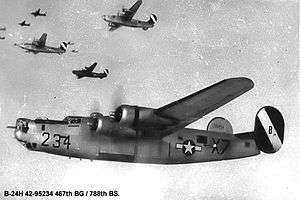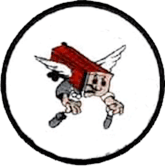789th Bombardment Squadron
| 789th Tactical Fighter Squadron | |
|---|---|
 467th Bombardment Group B-24 Liberators in combat formation | |
| Active | 1943-1946; 1965 |
| Country |
|
| Branch |
|
| Role | Bombardment, Fighter |
| Part of | Tactical Air Command |
| Engagements | European Theater of Operations |
| Decorations | French Croix de Guerre with Palm[1] |
| Insignia | |
| 789th Bombardment Squadron emblem (approved 19 January 1945)[1] |
 |
The 789th Tactical Fighter Squadron is an inactive United States Air Force unit. During World War II, as the 789th Bombardment Squadron it was assigned to the 467th Bombardment Group, and engaged in combat in the European Theater of Operations. From May to December 1944, the squadron was detached to the 801st Bombardment Group (Provisional) engaging in Operation Carpetbagger operations. After V-E Day, the squadron returned to the United States and transitioned into the Boeing B-29 Superfortress It was inactivated on 4 August 1946 at Clovis Army Air Field, New Mexico in August 1946.
The squadron was redesignated the 789th Tactical Fighter Squadron and activated in April 1965 as part of the 33d Tactical Fighter Wing. It began to train with the McDonnell F-4 Phantom II, but less than three months after activation, it was inactivated and its Phantoms, personnel and mission were transferred to the 40th Tactical Fighter Squadron.
History
World War II
Established as a Consolidated B-24 Liberator heavy bombardment squadron in mid-1943 and activated on 1 August. Trained under II Bomber Command in Idaho and Utah. In January 1944 the squadron received deployment orders for the European Theater of Operations. It moved to RAF Rackheath, Norfolk in England, February–March 1944, and became part of VIII Bomber Command.
Upon arrival in England it engaged in very long range strategic bombardment operations over Occupied Europe and Nazi Germany. In combat, the unit served chiefly as a strategic bombardment organization, attacking the harbor at Kiel, chemical plants at Bonn, textile factories at Stuttgart, power plants at Hamm, steel works at Osnabrück, the aircraft industry at Brunswick, and other objectives. It attacked German communications and fortifications during the Battle of the Bulge, December 1944 – January 1945. It hit enemy transportation to assist with Operation Varsity, the Allied assault across the Rhine, in March 1945.
After V-E Day in May 1945, the squadron was ordered back to the United States for Boeing B-29 Superfortress transition and redeployment to the Pacific Theater. It redeployed to the US June/July 1945. Upon arrival, most of the group was demobilized due to their combat service in Europe; a cadre of officers and men was formed at Sioux Falls Army Air Field, South Dakota on 25 August.
At Sioux Falls, the unit was reformed with newly trained pilots, aircrews and ground personnel. The reformed group was sent to Harvard Army Air Field, Nebraska for initial Second Air Force training. The Japanese Capitulation in early August canceled the planned deployment to the Pacific, however the group continued to train
Due to the advanced training state of the squadron received new B-29 Superfortresses and completed training. In December 1945 was assigned to a permanent base at Clovis Army Air Field, New Mexico as part of Continental Air Forces. The unit, however was inactivated on 4 August 1946 due to personnel shortages and funding reductions in the immediate postwar Air Force. The equipment and remaining personnel were reassigned to other SAC units.
Fighter operations
As the United States Air Force expanded its McDonnell F-4 Phantom II fleet in April 1965, it activated the 33d Tactical Fighter Wing at Eglin Air Force Base Florida. Although it was planned that the squadrons of the 33d Wing would be Convair F-102 Delta Dagger squadrons that were inactivating in the Pacific, these squadrons were still winding down their operations, so the 33d was initially formed with the 786th, 787th, 788th and 789th Tactical Fighter Squadron. The 33d embarked on a program of tactical training with the Phantom. In June 1965, the squadron was inactivated and its planes and personnel were transferred to the 40th Tactical Fighter Squadron, which moved on paper to Eglin from Yokota Air Base, Japan.[2]
Lineage
- Constituted as the 789th Bombardment Squadron (Heavy) on 19 May 1943
- Activated on 1 August 1943
- Redesignated 789th Bombardment Squadron, Heavy c. 10 August 1944
- Redesignated 789th Bombardment Squadron, Very Heavy on 5 August 1945
- Inactivated on 4 August 1946[1]
- Redesignated 789th Tactical Fighter Squadron on 9 February 1965 and activated (not organized)
Assignments
- 467th Bombardment Group, 1 August 1943
- VIII Air Force Composite Command, 11 May 1944 (attached to 801st Bombardment Group (Provisional))
- 467th Bombardment Group, 10 August 1944 – 4 Aug 1946[1]
- Tactical Air Command, 9 February 1965
- 33d Tactical Fighter Wing, 1 April 1965 – 20 June 1965[2]
Stations
- Wendover Field, Utah, 1 August 1943
- Mountain Home Army Air Field, Idaho, 8 September 1943
- Kearns Army Air Base, Utah 17 October 1943
- Wendover Field, Utah, 2 November 1943 - 12 February 1944
- RAF Rackheath (AAF-145),[4] England, 11 March 1944
- RAF Harrington (AAF-179),[4] England, 27 May 1944
- RAF Rackheath (AAF-145),[4] England, 10 August 1944 – 12 June 1945
- Sioux Falls Army Air Field, South Dakota, 15 July 1945
- Fairmont Army Air Field, Nebraska, 25 July 1945
- Alamogordo Army Air Field, New Mexico, 22 August 1945
- Harvard Army Air Field, Nebraska, 8 September 1945
- Clovis Army Air Field, New Mexico, 7 January–4 August 1946[1]
- Eglin Air Force Base, 1 April 1965 – 20 June 1965[3]
Aircraft
- Consolidated B-24 Liberator, 1943–1945
- Boeing B-17 Flying Fortress, 1945–1946
- Douglas C-47 Skytrain, 1944
- Boeing B-29 Superfortress, 1946[1]
- McDonnell F-4 Phantom II, 1965[3]
References
- Notes
Bibliography
![]()
- Anderson, Capt. Barry (1985). Army Air Forces Stations: A Guide to the Stations Where U.S. Army Air Forces Personnel Served in the United Kingdom During World War II (PDF). Maxwell AFB, AL: Research Division, USAF Historical Research Center. Archived from the original (PDF) on 23 January 2016. Retrieved 7 July 2012.
- Maurer, Maurer, ed. (1983) [1961]. Air Force Combat Units of World War II (PDF) (reprint ed.). Washington, DC: Office of Air Force History. ISBN 0-912799-02-1. LCCN 61060979. Retrieved December 17, 2016.
- Maurer, Maurer, ed. (1982) [1969]. Combat Squadrons of the Air Force, World War II (PDF) (reprint ed.). Washington, DC: Office of Air Force History. ISBN 0-405-12194-6. LCCN 70605402. OCLC 72556. Retrieved December 17, 2016.
- Ravenstein, Charles A. (1984). Air Force Combat Wings, Lineage & Honors Histories 1947-1977 (PDF). Washington, DC: Office of Air Force History. ISBN 0-912799-12-9. Retrieved December 17, 2016.

